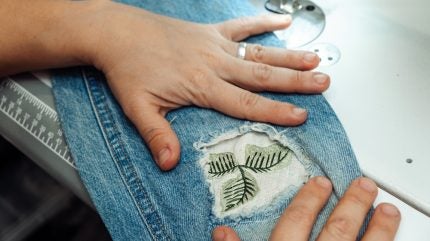
Between Instagram Shopping, Facebook Ads and Tik Tok Shop, the volume of items available to buy through social media can be overwhelming. And that doesn’t include all the products listed by social media influencers in their daily posts.
Following last year’s obsession with ‘de-influencing’ which saw social media users discourage their followers from buying items they don’t need, underconsumption core celebrates the use of things consumers already have.
What is underconsumption core?
Users of the #underconsumptioncore hashtag might show off repaired jeans, decades-old outfits or a pair of shoes completely worn out after years of use.
It is important to note that many social media users have noted that these habits are nothing new to those living on a budget. The recent cost-of-living crisis and rising inflation have both certainly added to the trend for make-do-and-mend.
Who is joining the trend?
Despite the popularity of underconsumption and related trends, it’s hard to ignore the success of ultra-fast fashion retailers such as online players Shein and Temu in recent years. So who is joining the trend?
GlobalData retail analyst Neil Saunders tells Just Style: “I think a lot of consumers like the idea of buying less and buying better, but many are also still pulled in by the allure of new fashions and trends. That is why fast fashion platforms like Shein are still growing.”

US Tariffs are shifting - will you react or anticipate?
Don’t let policy changes catch you off guard. Stay proactive with real-time data and expert analysis.
By GlobalDataA recent report from secondhand platform ThredUp on Gen Z’s relationship with fashion found one in three felt “addicted to fast fashion” despite 65% reporting a desire to shop more sustainably.
This addition seems to be inherently linked to social media.
The report also noted 40% of college students said they browse fast fashion sites or apps once a day or more. One in every two students said they watch fast fashion hauls on social media weekly or more often.
The statistics also suggest that despite Gen Z’s reputation for being conscious consumers, the allure of fast fashion is still a tough habit to break.
How will this impact fashion brands and retailers?
Saunders notes: “Underconsumption core has certainly gained ground on social media, but one of the important questions is how much is performative and partial versus being about consumers creating real and deep-seated changes to their buying habits.”
However, it’s clear the growing emphasis on secondhand apparel and ‘capsule wardrobes’ which encourage consumers to buy fewer items that last longer and work in many outfits, is increasingly important for fashion brands.
For example, British value fashion retailer Primark recently launched a trial swap shop in collaboration with circular company Verte.
Primark Cares director Lynne Walker said at the time of the launch: “We truly believe in helping people to love their clothes for longer and our latest partnership with Verte allows us to do just that. We hope our pop-ups will encourage more people to participate in the growing circular fashion economy.”
Earlier this year, British footwear retailer Schuh collaborated with Vintage Threads, a curated vintage and reworked clothing retailer, to launch a collection of 57 handmade pieces made from preloved footwear in time for Earth Day.
In March 2024, The Resale Report, written for online fashion thrift store Thredup by data research company GlobalData revealed the secondhand sector grew 15 times faster than the broader retail clothing sector in 2023.
Saunders adds that despite the unlikelihood of a huge impact on overall fashion sales, brands and retailers should pay attention to this growing trend.
He explains: “Ultimately, I think this means there won’t be too much impact on fashion in terms of overall sales. That said, brands would be wise to take a cue from the trend and emphasise things such as the durability, quality and longevity of their products.
“This feeds into the desire for value for money, which is as much about quality as it is about price.”



